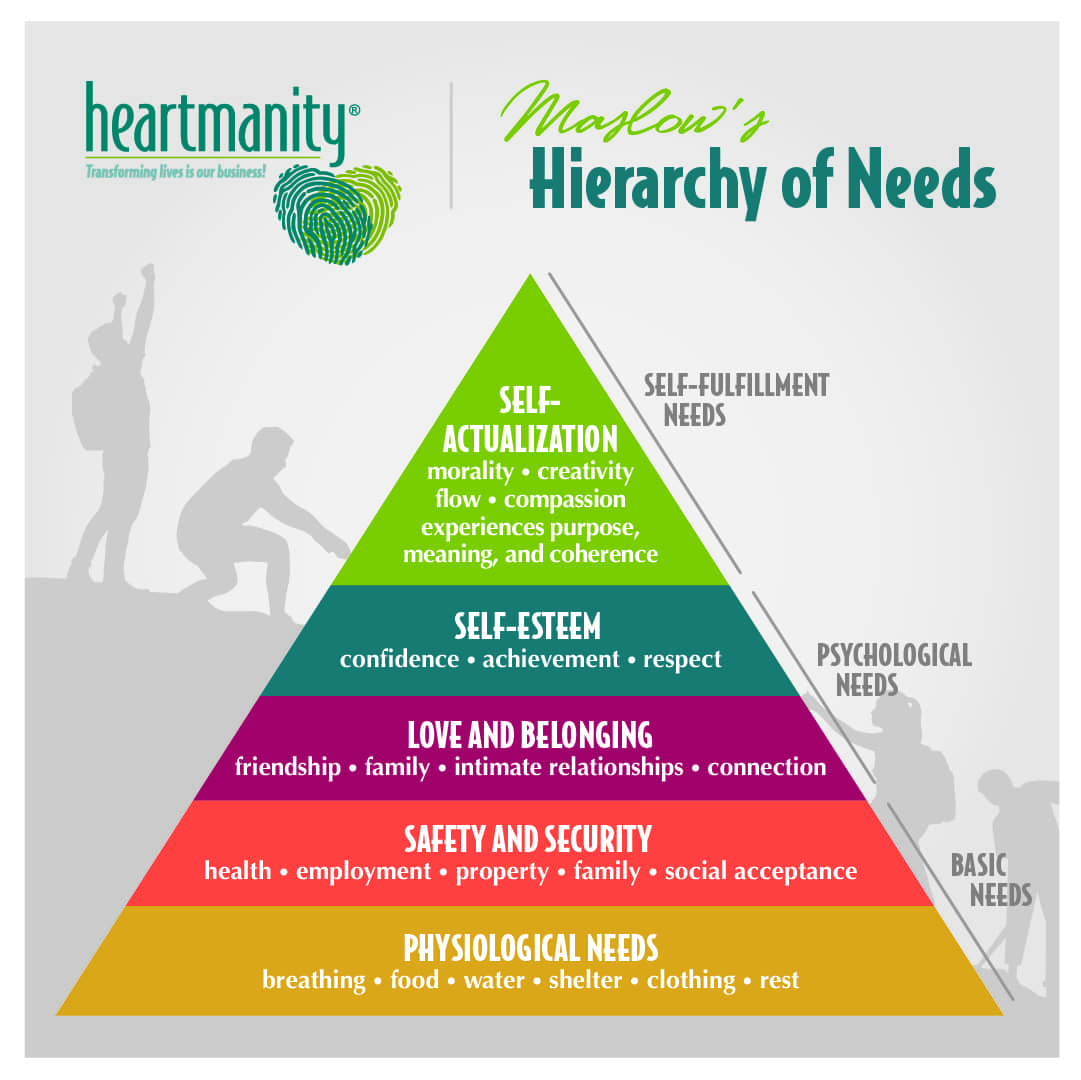If misbehavior keeps you from teaching effectively, these simple ways to redirect children’s behavior through meeting their needs will be beneficial. And if you are sans misbehavior, all the better! Then, Maslow’s Pyramid of Needs will help you build a safe and extraordinary community in your classroom.
Estimated reading: 4 minutes
 Heartmanity is proud to partner with outstanding companies that we wholeheartedly recommend so this post may contain affiliate links. You can read our full disclosure here.
Heartmanity is proud to partner with outstanding companies that we wholeheartedly recommend so this post may contain affiliate links. You can read our full disclosure here.
Although this information can be extremely useful, teachers get a lot of professional development thrown their way so this article could feel like déjà vu, "been there, done that."
Or you've been a teacher so long that new ideas seem few and far between. Others may be overwhelmed by lesson planning, correcting papers, parent-teacher conferences, and teaching (not to mention behavioral challenges.)
My intention is to make your job easier, not add one more thing to your list! So, discard whatever you don't relate to; skim the article for a gem that may resonate.
See if you can choose just one small key and apply it.
Small is BIG and can make a difference, but as you know so well, knowledge without application is useless.
Maslow's Hierarchy of Needs Provides a Valuable Framework
Maslow's Hierarchy of Needs offers a unique framework that educators can use to enhance student motivation and performance. Although teachers can't control every aspect of students’ lives, they significantly influence the classroom environment by addressing students' needs.
You're probably familiar with Maslow’s Hierarchy of Needs, but in case you aren’t or want to review it, below is the pyramid with the different levels and needs.
Related reading: "How to Apply Maslow's Hierarchy of Needs in Everyday Life."

Ways to Apply Maslow's Hierarchy of Needs in the Classroom
As a teacher, you’re an extension of parenting (like it or not!) Therefore, it is critical to understand that children’s unmet needs can cause misbehavior. If there is a deficiency at home, all the more nurturing and boundary setting may spill over to you.
So, how do you keep your eye on fulfilling your students' needs while carefully monitoring the group's energy and responsiveness to learning?
First, let's break down the first level in the pyramid.
Address Physiological Needs
Of course, teachers already ensure that students have access to essentials such as water and a comfortable classroom temperature to help them focus and learn. However, ask yourself, “What are some additional ways I can enhance their sense of safety and comfort?”
For example, you could provide a water dispenser within the classroom with sliced fruit or mint to make hydrating more appealing. Plan scheduled snack breaks that can also act as a reset for the brain. Ideally, offer or suggest they bring nutritious snacks that boost energy and concentration.
If the school provides snacks for children, how can you best utilize those snacks to match a snack break in the classroom? Consider providing healthy options like fruits, nuts, or granola bars. These snacks are especially beneficial for children who may not have healthy diets at home.
The other thing to consider is the temperament of your children.
- Are there children with high sensitivity who may be more susceptible to the classroom's warmth—or lack?
- Is there a whining noise that is distracting or annoying?
- Is the lighting adequate for reading or is the sun through the windows blinding for some children? (Children with high sensitivity are particularly reactive to light intensities.)
- Are there visuals for those who love details (high perceptivity in temperament) and information for children who prefer the big picture of a subject?
- Is there a self-quieting corner where a student can calm themselves? (For lower adaptive children and to encourage emotional regulation.)
Safeguard Safety Needs
Many teachers are great at creating a safe and stable environment with clear rules and a respectful classroom culture.
However, you can increase this safety by establishing your classroom as a no-putdown zone. Lowering your tolerance for sarcasm and zingers will create more emotional safety for your children, reducing bullying as a bonus.
One helpful tool is to mark off a 1'x1' square with electrical or masking tape, big enough to stand inside. This space becomes a self-calming or quiet square. When a child (or you) are inside it, no one can talk to them, and they practice silence and self-calming. In order to talk, they must step outside the taped area.
A visual representation of a boundary is helpful to the brain for practicing boundary setting and can be effective in helping children respect personal space and learn self-control and self-calming. And it can be used for your to take five without being pestered.
(See the ideas below for increasing emotional literacy and empathy.)
Meet Social Needs by Building a Sense of Belonging
Cultivate a welcoming atmosphere where students feel supported and accepted by peers and teachers. These social needs can be fulfilled through group activities, class discussions, a buddy system for projects and free time to converse with each other.
A sense of belonging is a high-value need, and provides safety for the brain. Our technological age can create a vacuum for personal, in-person interactions and attract kids to gaming communities or unhealthy addiction to social media.
The more creatively you help children feel like the classroom is their learning home and give them ways to belong, the more likely they will want to be there to learn. For instance, encouraging them to help another student in math gives them the added purpose of helping, giving value and purpose.

Build and Nurture Healthy Self-Esteem
Nurturing healthy self-esteem in the classroom using Maslow's Hierarchy of Needs provides teachers with a comprehensive and holistic approach to student development.
By addressing the needs at each level of the pyramid, educators create an environment conducive to building strong self-worth. One of the keys to developing healthy self-esteem is through positive and meaningful feedback.
Encourage students by recognizing their achievements and providing constructive and effective feedback. See the essential elements below to make your feedback more impactful.

A fantastic activity to reinforce confidence is by creating a "wins" journal. Have the students keep track of their daily accomplishments, big and small breakthroughs, reinforcing positive self-perception and building confidence. Or journaling about what they're most proud of is also a great way to highlight and bolster maturing skills, strengths and talents.
Make Goal-Setting a Regular Practice
Sometimes, adults (teachers and parents alike) think children should know how to set goals, but many adults still struggle with this practice. Goal-setting is a skill like language or mathematics. It needs to be taught and nurtured.Empower them to build self-confidence by setting achievable goals and learning to cheer for their classmates, too.
Facilitate Peer Recognition
Create a classroom culture where students can share positive feedback. These opportunities are excellent for building verbal and social skills. Provide structured activities where students recognize each other’s contributions or efforts, and you discuss how to give recognition in a meaningful way.Peer appreciation not only enhances self-worth but also encourages a supportive learning environment.
Encourage Participation in Extracurriculars
Spur students to engage in various competitions and extracurricular activities. Participation in such events allows students to explore different skills and passions, helping them discover their strengths and build confidence.
Whether it’s a science fair, a sports event, or an art contest, these activities provide valuable opportunities for personal growth and self-recognition.
Promote Self-Actualization in Your Students
As you can see from the pyramid above, self-realization doesn't happen without safety. After basic needs are met, you're then able to move to motivation to greater self-awareness and actualizing.
Inspire students to pursue personal growth and creativity. For instance, if you are aware that a child or teen is very interested in mechanics, plan a project or lesson around that topic. Take a field trip to a mechanic’s shop and explore the field. If the child’s father is a mechanic, perhaps he gives a lesson at his shop, which helps to build a bridge from classroom to home and back!
If a student tends to be unusually self-aware for their age, have them share their thinking or how they arrived at their conclusions. Offer opportunities for self-directed learning, allowing them to build a growth mindset.
Recognize the hard work and dedication students put into their tasks. Acknowledging their efforts with meaningful, affirmative feedback can significantly boost their self-esteem.
Instead of generic praise, “Great job!” tailor your compliments to highlight specific achievements, such as, "I noticed how much effort you put into solving that problem—excellent work!"
By thoughtfully integrating these components into educational practices, teachers can more effectively motivate students and enhance their learning experience.
Now, let's get creative in how we apply these principles within the framework of Maslow's Pyramid of Needs.
Related reading: More Innovative Teaching Strategies.
Creatively Implement Maslow's Hierarchy of Needs in the Classroom
Okay, we’ve covered the foundational work to meet your students’ needs. Now, it’s time to apply this information creatively!
Below are five innovative and unique ways teachers can apply Maslow's Pyramid of Needs to build a supportive classroom and promote self-awareness and emotional literacy.
Emotional Weather Station
Create a digital "weather station" in the classroom where students can anonymously update their emotional state using weather-themed icons (e.g., sunny for happy, cloudy for confused, stormy for upset).
This planned activity addresses the safety and belonging needs by allowing students to express themselves without judgment. Teachers can use this group’s real-time data to adjust their teaching approach, offer support, or initiate class discussions on emotional well-being.
Skill Swap Marketplace
Establish a classroom marketplace where students can offer to teach mini-lessons on their unique skills or interests to their peers. This method addresses esteem needs by valuing each student's talents and knowledge. It also promotes belongingness by creating a culture of peer learning and mutual respect.
Sensory-Adaptive Zones
Design flexible learning spaces with different sensory experiences to cater to various physiological and safety needs.
For example, create a cozy corner with soft lighting and comfortable seating for students who need a calming environment, a movement zone with standing desks or balance balls for kinesthetic learners, and a collaboration hub with interactive technology for group work.
These corners ensure you’re meeting your students' different learning styles and varying temperaments.
Virtual Reality Empathy Missions
Use VR technology that kids love to create immersive experiences teaching students to empathize with others’ experiences and perspectives. When we experience something, we are much more likely to understand empathy and how to empathize.
These missions could simulate various life challenges or cultural experiences to understand diversity better. The in-depth virtual experiences also address belonging and self-actualizing needs by nurturing empathy and global awareness. Follow up with reflective discussions and action planning for real-world impact.

Classroom Constitution Evolution: Instead of a static set of rules, create a living Classroom Constitution that evolves throughout the year. Students can propose amendments, debate changes, and vote on new guidelines periodically.
You appropriately give children and teens an increased sense of power, reducing misbehavior and push-back when you allow them to participate. By giving students a voice in shaping their learning environment and practicing democratic processes, power struggles go down and learning goes up!
Allowing students' input in designing the rules of engagement of the classroom fulfills their need for being safe, valued, and belonging. They're no longer pawns to be moved around on the chessboard; they are learning how to manage themselves and work as a team.
This small mindset shift is HUGE for empowerment!
Closing Thoughts
Sometimes, no matter how enthused we are about new information, it can feel overwhelming.
Start by introducing just one idea that resonated with you.
Take consistent actions to establish a classroom culture that prioritizes respect and builds a foundation of self-care for the fulfillment of needs, stimulating a desire to learn.
Children and teens need to learn that when their needs are not met, the ability to learn goes down.
Basic needs at the bottom of the pyramid MUST be met before greater learning is possible. As a teacher, you do not want your students' basic needs competing with your teaching.
Use Maslow's Pyramid to more effectively attune to what's most important throughout each day.
Meeting your students' needs IS a shortcut to prevent or redirect misbehavior. It will make your teaching SO much easier!
Test it out!
To discover more ways to increase your emotional intelligence at work, read "27 Best Ways to Raise Emotional Intelligence in the Workplace."








